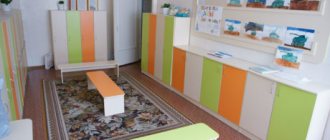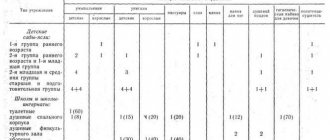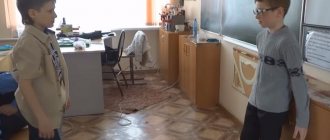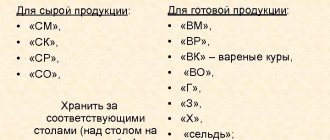Requirements for the daily routine in preschool educational institutions according to SanPiN
The standard daily routine in kindergarten is designed for 12 hours, which the child spends within the preschool walls. Any adjustments are made taking into account climatic conditions, geographical location, and other factors. The regime is drawn up in accordance with sanitary and epidemiological rules and regulations SanPiN 2.4.12660–10. Key points:
- The kindergarten provides four meals a day with a time interval of 4 hours between meals.
- There are 2 walks in the fresh air - in the morning and after a nap. In total, walking with children requires 3–4 hours. The time spent outside is reduced at temperatures below –15 °C and wind speeds of 7 m/s.
- According to the daily schedule, nap time is 2–2.5 hours, while the teacher must be present in the bedroom and monitor the sleeping children.
- It is required to ventilate the room for less than 10 minutes. every 90 minutes If there are no children, arrange ventilation 30 minutes in advance. before they arrive from the street or classes. The air temperature should not drop more than 2–4 °C; it is important to avoid drafts.
- Bed linen in kindergarten must be changed at least once a week (according to the schedule).
- In the cold season, the teacher should meet the children in the morning in the group, in warm weather - outside (at the group site).
Diet
| Time | Eating | Approximate menu |
| 8:30 | Breakfast | A hot dish (milk porridge, cottage cheese casserole, egg omelet), tea or cocoa, a sandwich with butter and cheese. |
| 10:00 | Lunch | Drink with or without fruit. |
| 12:00 | Dinner | First course (borscht, soup), second (side dish with meat or fish), salad or vegetables, cold drink. |
| 15:00 | Afternoon snack | Baking (bread), drink. |
| 18:00 | Dinner | Meat or fish dish, cottage cheese, drink. |
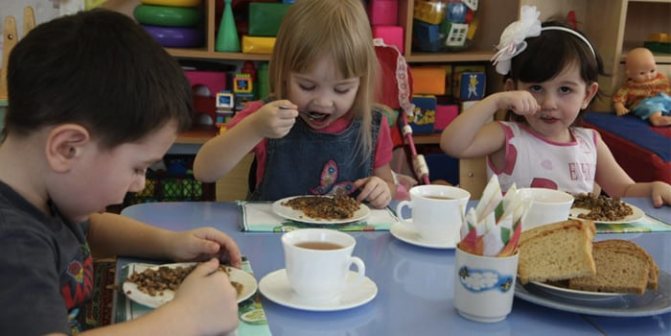
Kindergarten classes
In kindergarten, they develop speech skills, broaden their horizons, introduce them to the basics of mathematics and writing, instill a love of creativity and culture, and provide new knowledge. In the absence of medical contraindications, classes are conducted in the following areas:
- physical training;
- music, singing;
- art;
- mathematics;
- development of speech, logic, fine motor skills;
- preparation for school.
In kindergarten, independent games are held, when children communicate with peers, make friends, and relax. There are no more than 3 classes per day in kindergarten, with a break between them of at least 10 minutes. Lesson duration:
- junior group (children 3–4 years old) – 10 min.;
- middle group (4–5 years) – 15 minutes;
- senior group (5–6 years old) – 20 min.;
- preparatory group (6–7 years old) – 30 min.
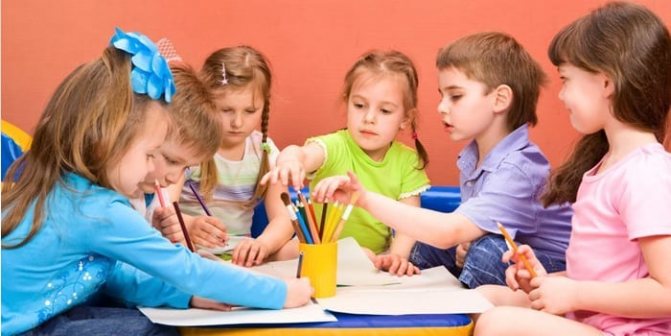
Physical development classes
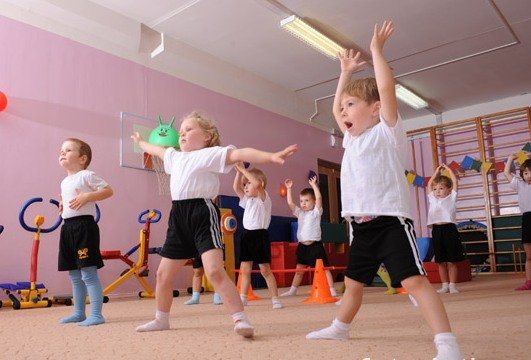
Their duration ranges from 15 to 30 minutes depending on the age group. In summer, such activities are recommended to be carried out outdoors. In addition to physical development classes, other forms of physical activity are also used: morning exercises, physical exercises, outdoor games, and in some kindergartens - exercise classes, swimming, etc.
Morning reception for children
Reception of children should be carried out by educators and (or) medical workers. Identified sick children or children with suspected illness are not accepted. If a child falls ill during the day, he is isolated from healthy children (placed in a medical room) until the parents arrive or are hospitalized, with the parents informed.
How's lunch going?
After everyone has returned from the walk, the children on duty must fulfill their duties: they help the nanny set the tables (put napkins and plates under the bread, arrange cups and saucers, lay out spoons and forks). The teacher calls the dishes on duty that will be served for lunch today.
Before starting to eat, a mandatory routine moment is carried out - washing: the teacher draws the children’s attention to ensure that they correctly develop cultural and hygienic skills. Then the teacher invites everyone to sit at the tables, making sure that the children sit upright, their legs are straight, and their elbows are not lying on the table.
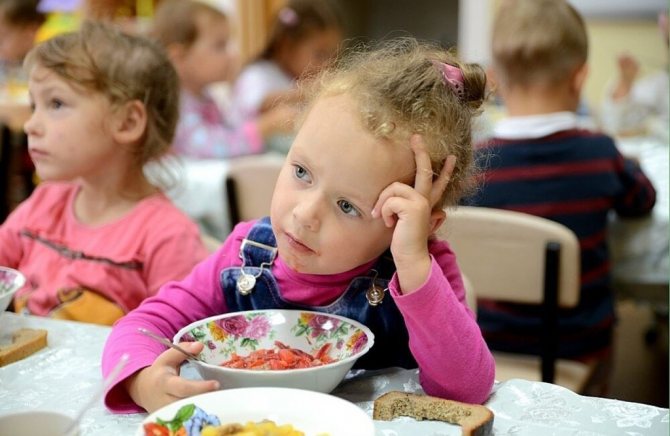
The child on duty talks about what will be for lunch today and wishes you a bon appetit.
During lunch in kindergarten, the teacher can tell you that eating is very healthy - children grow quickly, become strong and never get sick. They try to convince kids who don’t eat to chew at least a little.
When lunch is over, the kids get up from their tables, say thank you, and put away their cups. The children on duty diligently help clean up the dishes, taking their time, holding them with both hands.
Daily routine in kindergarten
The daily routine in kindergarten depends on the age of the child, the specialization of the preschool educational institution, and other factors at the discretion of the teacher (methodologist, management). Activities that require increased mental stress for children are carried out in the first half of the day, alternating with physical education, music, and fine arts. This is important in order not to overload the child, to make him a comprehensively developed personality to the delight of dad and mom.
Nursery group (2–3 years)
It is important to follow the daily routine in kindergarten from the nursery on. This is necessary so that the kids adapt faster. It is important to speed up the process of getting used to the teachers and nanny so that the child does not worry and goes to kindergarten with joy every morning. Approximate daily schedule:
| Time | Daily regime |
| 7:00–8:00 | Reception of babies |
| 8:00–8:20 | Breakfast |
| 8:20–9:00 | Independent games in a group |
| 9:00–9:30 | Preparing for the walk |
| 9:30–11:30 | Street games |
| 11:30–11:45 | Return to the group, preparation for lunch |
| 11:45–12:15 | Dinner |
| 12:15–12:30 | Preparation for sleep |
| 12:30–15:00 | Quiet hour |
| 15:00–15:15 | Waking up after a nap |
| 15:15–15:30 | Afternoon snack |
| 15:30–15:45 | Stand alone games |
| 15:45–16:15 | Group classes |
| 16:15–16:30 | Preparing to go outside |
| 16:30–18:00 | Walk |
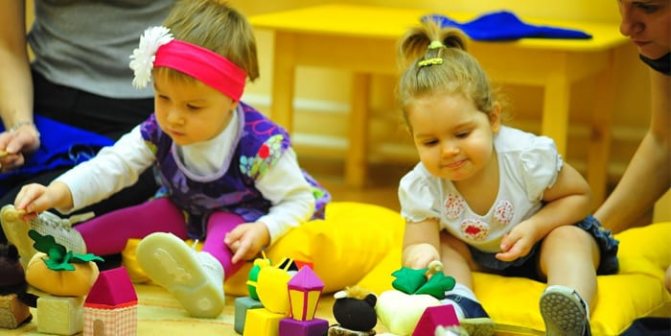
Junior group (3–4 years old)
| Time | Daily regime |
| 7:00–8:20 | Reception of children, morning exercises, games |
| 8:20–8:50 | Preparing for breakfast, eating |
| 8:50–9:20 | Games, preparation for classes |
| 9:20–10:00 | Classes |
| 10:00–10:20 | Preparing for the walk |
| 10:20–12:20 | Outdoor recreation |
| 12:20–13:00 | Dinner |
| 13:00–15:15 | Quiet hour |
| 15:15–15:45 | Awakening, games, air procedures |
| 15:45–16:00 | Afternoon snack |
| 16:00–16:30 | Games, physical activity |
| 16:30–16:50 | Gathering outside |
| 17:00–18:00 | Walk |
Middle group
The schedule in the kindergarten for the middle group is almost identical to the schedule of the 2nd junior group. The only change is the appearance of circles.
Senior group
In the older group, the differences become significantly greater:
- the first walk is 10 minutes longer;
- second breakfast 5 minutes faster;
- “quiet hour” is shorter by another 30 minutes;
- 5 minutes more time is allocated for mugs and GCD;
- the time of the first walk is increased by 10 minutes;
- the second walk is 15 minutes shorter;
- The preparation time for dinner and the dinner itself increases by 15 minutes.
Preparatory group
For the preparatory group, lunch and preparation for it take half an hour, and their schedule is no different from the older group; they need to study in the same way.
Correct daily routine for a 3 year old child
hope lutai
Correct daily routine for a 3 year old child
CONTENT:
Peculiarities of age Main routine moments What to fill the day with? Standard daily routine
At the age of three, the child becomes more active. He needs a lot of energy for games and cognitive activities, communication with peers. To do this, it is important to provide him, first of all, with adequate day and night rest and proper nutrition . What should be the daily routine for a 3 year old child ?
FEATURES OF AGE
At 3 years old, the child enters a new stage of development. He becomes a member of society, so communication with his parents is no longer enough for him. Communication with peers is of great importance. If a child does not yet attend kindergarten, he needs to be provided with communication with other children on the playground. You can enroll him in an early development group so that he gradually gets accustomed to children's society. If the baby went to preschool, he will have to be put to bed and woken up early in the morning. Find out the daily routine of the kindergarten your baby will attend, and gradually teach your child to sleep , eat, and stay awake at the right time. This transition can take up to six months, so you need to take care of it in advance. Now the baby is already able to stay awake for about 5–6 hours, his need for rest is slightly reduced. So, daytime sleep is now left alone and can last about 1.5–2 hours. But it must be present - while the child still cannot do without daytime rest. This situation will continue until 6–7 years. The baby's physical activity increases significantly. He already overcomes obstacles with ease, can ride a bicycle, swing, run and jump for a long time, climb onto heights, and jump off. old child’s routine should include enough time for active games and physical activity.
MAIN MOMENTS
The daily need for rest for three-year-olds is about 11 hours: 9 are for night sleep, approximately 2 hours for daytime sleep. It is best to put your child to bed after lunch , when he is tired enough after a morning walk. It is advisable to organize a night's sleep no later than ten in the evening. It is important that he sleeps 9 hours before 7 am in order to be on time for kindergarten if he goes there (or to get used to this routine)
.
-year-old child eat at least 4 times. This includes breakfast, lunch, afternoon tea and dinner. Products must provide the child with the necessary supply of energy and nutrients so that he can be physically and mentally active during the day, and therefore develop properly . If the weather permits, you need to walk outside for at least 4 hours a day: before lunch and before dinner. At the same time, during the warm season, all free time should be spent outdoors. This will have a beneficial effect on the baby’s appetite, sleep and overall development.
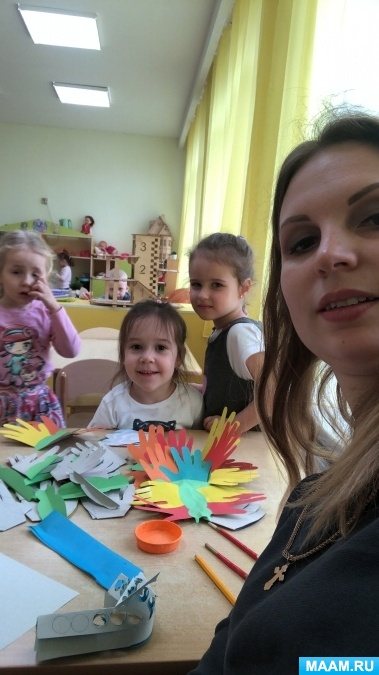
IT IS IMPORTANT!
Try to get your baby out of the habit of snacking between meals. Otherwise, he simply will not be hungry at the right time. It is especially harmful to snack on flour or sweets. Explain to your relatives that you don’t need to feed your child cookies or chocolates to win his favor. There are more useful things for this. For example, fun games, songs or dances.
WHAT TO FILL YOUR DAY?
Let's start with the fact that the day of a three-year-old child should not go “point by point”
from waking up to going to bed.
There is always free time between meals and bedtime. Therefore, it is important to know what and when you can do with your child . After waking up, you need to teach your baby to participate as much as possible in making the crib and folding his pajamas. This will help the child get used to being independent at home. After sleep and before going to bed at night, water procedures are important. In the morning, the child must wash his face and brush his teeth. In the evening, in addition, take a swim. To practice your toothbrush skills, you can hang a visual aid near the sink. To make bathing more fun, take special toys with you to the bathroom. (By the way, these can be ordinary bowls-mugs with which the child will pour water, empty shampoo bottles for “water shooting”
).
Hands must be washed before each meal. Physical activity begins with morning exercises (read more about this here)
.
Charging should last at least 15 minutes and include exercises for the arms, legs, head, and torso. This will help awaken the entire body. To make studying more interesting, you can turn on funny music (for example, from your favorite cartoon)
.
In summer, it is better to do exercises in the fresh air - in the yard or on the balcony. Children at this age learn from the example of their parents, so mom or dad will certainly do the child
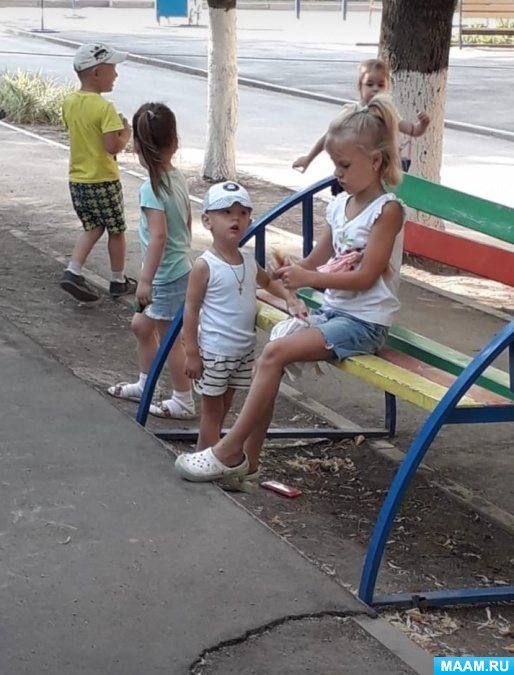
During walks, the child should move as much as possible: jump on ladders, logs, slides, jump on trampolines, ride a swing, bike or scooter, run and frolic in the company of other children. Free time between walks, meals and sleep should not be “empty”
.
The child can play independently (draw, do construction, sculpting, or together with his parents, including educational games. It will not be superfluous to involve the baby in household chores. Let him help his mother wipe the dust, clear the table, put the laundry in the laundry , disassemble after drying. During such work the child will unobtrusively get acquainted with many household appliances, the mother will tell him how they work, what they are needed for. And this is the development of cognitive activity, broadening his horizons and simply getting involved in helping parents with household work. It is important to remember that 2-3 hours before bedtime, activities should become calmer: running and jumping is not advisable now, the baby needs time to calm down and prepare for bed. You can draw, read books, look at and describe pictures, play with mosaics.
THIS IS IMPORTANT!
Buy a calendar that shows the year, month, date, day of the week, and also has the ability to move the numbers. Every morning, talk to your baby about what day it is today. The baby will learn to navigate in time, and awakening will be smoother.
STANDARD DAY ROUTINE
In fact, there is no universal routine for three-year-olds. As for children of other ages, since each family has its own way of life, mom and dad have their own work schedule, they have their own interests, other brothers and sisters in the family also have their own needs. Therefore, routine of one family member should not disrupt the routine of others. When compiling it, you can focus on a certain established standard, which needs to be adjusted to specific circumstances. It looks like this:
- 7:00–7:15 – getting up, water procedures;- 7:15–8:30 – morning exercises;- 7:30–8:00 – time for the baby to study independently or help mom set the table;- 8:00 –8:30 – breakfast;- 8:30–9:30 – educational games with mom;- 9:30–11:30 – morning walk;- 11:30–12:00 – preparation for lunch (changing clothes, washing hands , cleaning up toys that were taken with you, helping mom); - 12:00–12:30 – lunch; - 12:30–14:30 – afternoon nap; - 14:30–16:00 – awakening, child’s independent play within sight of mom ;- 16:00–16:30 – afternoon snack;- 16:30–18:00 – second walk in the park or on the playground;- 18:30–19:00 – dinner;- 19:00– 20:00 – quiet games; - 20:00–20:30 – cleaning toys, cleaning the room; - 20:30–21:30 – bathing, massage, evening bedtime ritual, sleep until morning.
The daily routine is the basis that helps to distribute the necessary activities and actions over the hours, organize them and master this order. And this means order in life, stability, which is so important for the child’s psyche.
Standards for diet
A preschooler has taste preferences that are unusual for adults and has a weak immune system, so all products served to preschool children must be accompanied by a permit certifying their safety and quality in accordance with government regulations. Among the standards, a separate category includes the procedure for preparing a dish and at least one rule for storing an ingredient.
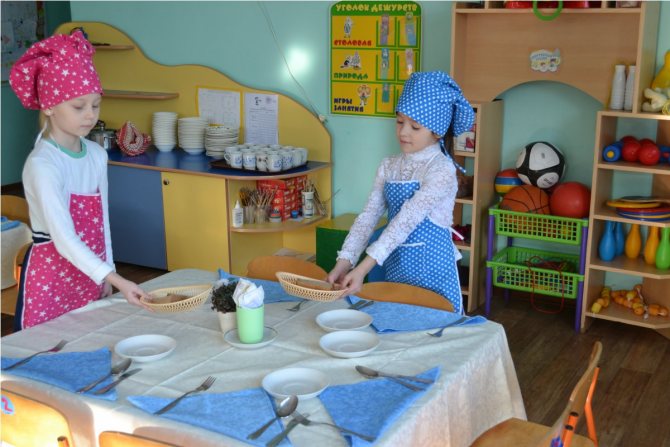
Nutrition in preschool educational institutions is carefully monitored
There are no uniform requirements for the menu, since the diet of residents of different regions can vary greatly. There is only a directory containing more than a thousand recipes for dishes acceptable for consumption in preschool educational institutions. The routine is drawn up based on the schedule. The kindergarten provides:
- 2 breakfasts;
- dinner;
- afternoon snack;
- 2 dinners.
Important. If the child is in kindergarten for up to 8 hours, there should be 4 meals, and a four-hour interval is the maximum allowable.
The first thing that needs to be done before drawing up a diet for students is a technological map, that is, a document that displays basic information about the cooking process and its nutritional value. Namely:
- name of the dish;
- number of the recipe used;
- recipe source;
- a list of all products, their weight;
- final weight of the dish after cooking;
- the content of proteins, fats, carbohydrates and vitamins in one serving of the dish;
- its nutritional value.
It is possible that to obtain the necessary information you will need to consult a nutritionist.
There must be variety!
Lunch in kindergarten should be varied. For example, since there are first courses with cereals and potatoes, the side dish for the second course no longer needs to be prepared from the same products. You should also avoid using dishes that are made from the same thing - as an option - pasta in soup and side dish.
When creating a menu for lunch, you need to pay attention not only to the variety of dishes available throughout the day and the whole week, but also to how foods of plant and animal origin are combined. It is important that children receive one cereal and two vegetable dishes every day.
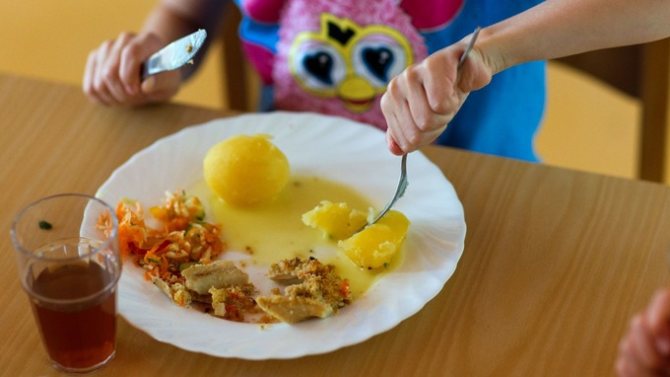
Having as wide a range of foods as possible on the menu (meaning a menu for the whole day or week) will ensure that children get enough of the nutrients they need. One of the important conditions is the variety of dishes that are made from the same product.
Approximate daily routine in a regular preschool educational institution
The daily routine in kindergarten consists of:
- diet, namely the time and number of meals;
- daytime sleep;
- walks;
- children's reception time;
- games and activities.
Teachers accept children to the kindergarten from the moment it starts working until 8 o'clock in the morning. The period while the reception lasts is a time for independent games in the group room or on the playground in the warm season. Before breakfast, time from 8.00 to 8.20/8.30 is allocated for morning exercises with a teacher or physical worker and for preparing for breakfast.
Morning classes
Starting from 9.00, classes are held for children aimed at helping them learn about the world around them, develop their speech skills and become familiar with the basics of mathematics. Teachers are responsible for conducting classes. They must prescribe an activity plan in advance in order to meet the allotted time. In addition to the teacher, a music worker and a physical educator can also work with the kids.
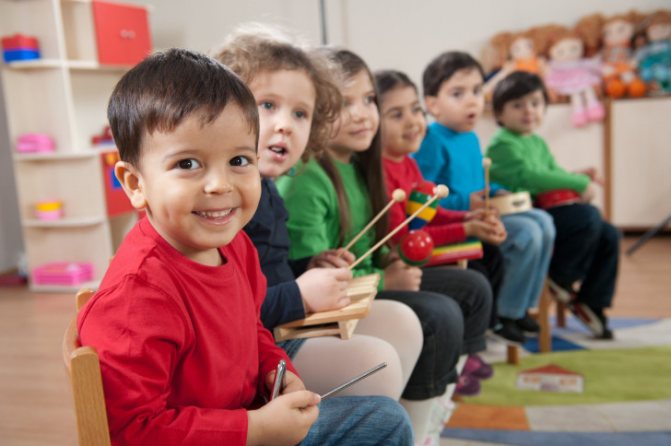
In addition to regular group classes, children can visit the pool 2 times a week, if available. In senior and preparatory groups, additional classes with a speech therapy focus are also organized, in which children train their speech. Only a speech therapist teacher is required to conduct them.
The duration and number of classes depends on age. For younger preschoolers, there are 2 classes a day, one before bedtime, the other after. In the middle group, the teacher works with the kids twice a day for a total of 10 hours. For older preschoolers, the number of classes increases to three, and their duration also increases.
Between classes there should be mandatory breaks when the children rest and move. This is the only way to keep your child active and cognitively active throughout the day.
Walks and naps
After classes are over and the children have had their second breakfast, it's time for a walk. In the nursery, the walk begins earlier than in other groups, and therefore also ends earlier; the children in them are the very first to have lunch. Since children go to the nursery group at 2-3 years old, taking into account the characteristics of a small body, wakefulness time is reduced, and daytime sleep, on the contrary, becomes longer.
With age, the child’s period of activity increases, thereby the baby’s body gradually prepares for school and the regime in it. In the middle group, walks usually last until 11.30-11.50, and in the preparatory group - up to 12.15-12.30. After returning from the street, the children will have lunch and a nap. The room where children sleep should be ventilated in advance, and the beds should be prepared for bed. The youngest go to bed at 12.30, the oldest at 13.00-13.15.
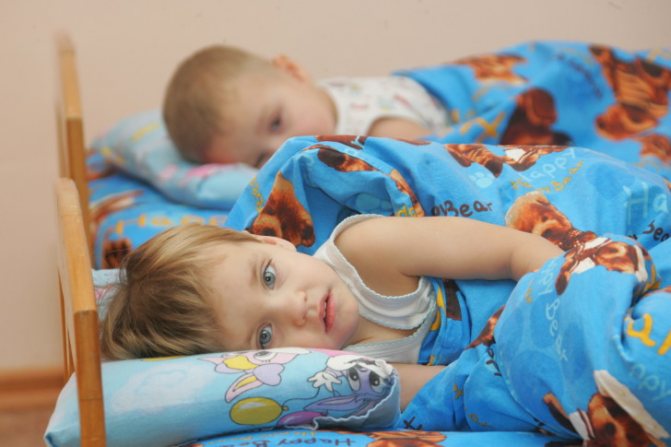
Afternoon
The rising time in kindergarten is the same for all groups. The children are woken up at 15.00, followed by washing, changing clothes and an afternoon snack. In the younger groups, after this, a second general education lesson is held, in the middle and older groups it is time for the children to play independently, read, cartoons or attend clubs that are available in the institution.
Evening meal times may vary depending on the schedule. After dinner, the kids usually go out for a walk again, where their parents gradually begin to come for them. In winter, the second walk does not last long, so the children are taken home to the group premises.
Meal plan. Dinner
Let's look at the plan using the example of the middle and senior groups.
So, one of the important meals is lunch in kindergarten. The time it lasts is approximately thirty minutes.
There are several eating tasks.
- Educational - instills the need for cleanliness, neatness, politeness, and the correct attitude towards eating.
- Developmental - chewing muscles of the face and fine motor skills develop.
- Educational - a culture of behavior during meals is formed (eat carefully and independently, use cutlery correctly); do not crumble bread; When chewing food, do not open your mouth; do not talk while eating; push in a chair without making unnecessary sounds; say words of gratitude after eating; The habit of a healthy lifestyle is also formed.
Home mode
What should you do if, for some reason, your child does not and will not attend kindergarten? Sticking to the same regime is a definite thing. True, with some nuances. The first of them is that the baby can be allowed to wake up a little later (since there will be no time needed to travel to the kindergarten). Secondly, you can also put the baby to bed later.
Another subtlety is that parents will have to organize educational activities for their child themselves. To do this, it is advisable to familiarize yourself with the requirements for preparing a child in the school that the child will attend in the future, and try to prepare the child in accordance with them. Of course, you can also attract specialists to help (for example, enroll your child in an early development group or with a teacher who will take on the role of a kind of tutor). But if you have confidence in your own abilities, then it is better if the parents teach the preschooler. This way they will have the opportunity to once again (which is not at all superfluous!) demonstrate to him their love, interest in his development and pride in his first achievements.
You will have to do the same things as in the garden: teach writing, reading, drawing, sculpting, dancing, teaching basic mathematical concepts, developing speech, studying nature, playing, developing the child physically (independently or in a sports section), and be sure to accustom him to work. Among other things, mothers are entirely responsible for their child’s diet.
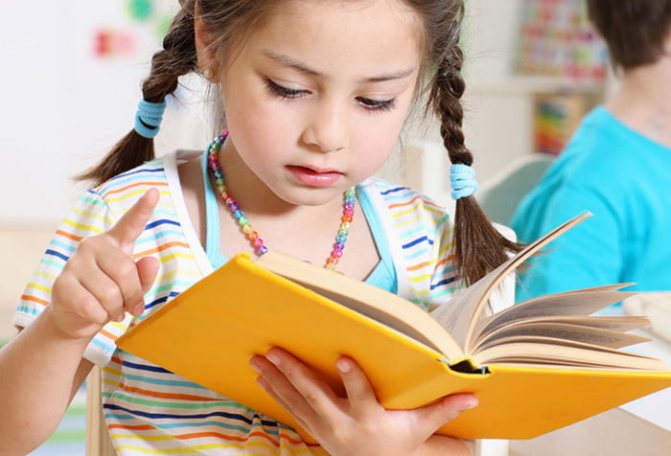
Diet for children 3–7 years old with a 10.5-12 hour stay in a preschool educational institution
Diet for children 3–7 years old with a 10.5-12 hour stay in a preschool educational institution
In preschool institutions, meals are organized in accordance with SanPiN 2.4.1.1249-03 “Sanitary and epidemiological requirements for the design, maintenance and organization of the operating mode of a preschool educational institution,” which, depending on the operating mode of a particular educational institution, provides for five or three meals a day in preschool educational institutions ( Table 17
).
Table 17
Diet of preschool children depending on the time spent in preschool educational institutions
(extract from SanPiN 2.4.1.124903)
From a physiological point of view, the food setting of the diet is associated with the appearance of a feeling of hunger, the theories of the origin of which were studied by A. Carlson, W. Cannon, and others. It is this feeling in both humans and animals that is associated with the search and consumption of food. The rate of change from a feeling of satiety to a feeling of hunger depends on the rate at which nutrients are consumed by the body, i.e., on the level of energy expenditure. Therefore, breaks between meals during the day should be of different durations: at night, with minimal energy consumption, - 8-10 hours, during the day - from 3 to 5 hours, depending on the level of physical activity. However, a uniform load on the digestive tract, the most complete processing of food with digestive juices that are full of digestive activity, is ensured by a diet - ordered meals at strictly defined hours.
For an adult (and a child from 3 years of age switches to the adult diet), four meals a day with an interval of 3.5–4 hours and food distribution according to calorie content are optimal: 25% for breakfast and dinner, 35% for lunch and 15 % – for an afternoon snack (second breakfast or second dinner).
Get the full text See all projects
Publish articles
The physiological justification for such a regime in a preschool educational institution raises serious objections, since it does not take into account the distribution of energy loads in the daily routine of the institution. The maximum energy load of lunch, which in adults is justified by subsequent physical (work) stress, in children does not correspond to the subsequent decrease in energy expenditure during the daytime rest. As a result, children come to the afternoon snack without a formed feeling of hunger, and it attracts them only with its pleasant taste associations. A forced meal in the afternoon extinguishes that natural need for food, which should have developed in the child an hour and a half later. Dinner also turns into force-feeding, but without the same taste. It is not surprising that half of the institutional dinner goes to waste, and the children, before they get home, ask for food, causing quite fair complaints from parents about the preschool educational institution.
In addition, the four-meal diet in the preschool is designed for a 5-day working week of parents, with the end of the working day at 18.00, when the child is picked up from the preschool at 19.00. But another part of the parents who work six days a day finish their work day at 16.00–17.00 and pick up their children earlier. This is the reason for transferring all children to an earlier dinner, which does not take into account the children’s mood for eating.
Objections to the four meals a day diet are significant and require its modification, taking into account the use of physiological principles for constructing the diet of children in preschool educational institutions. We suggest that you stop force-feeding children. If the child is full after a nap, you need to give him the opportunity (and even help) to get hungry, and then feed him well. In these conditions, eating for both children and teachers will be a holiday, not torture.
The three-meal diet for preschool children with a 10.5-12-hour stay in a preschool educational institution with an enhanced afternoon snack (instead of an afternoon snack and dinner) is shifted in the daily regimen by 1 hour
(at 17.00 instead of 16.00).
In a kindergarten, such a diet covers 80–85% of the daily calorie intake, distributed among meals: 20–25% for breakfast and an enhanced afternoon snack, 35–40% for lunch and 15–20% for home-cooked
dinner.
The system of three meals a day in a preschool educational institution with an enhanced afternoon snack, instead of an afternoon snack and dinner, is not new and has been introduced in many regions of both Russia and neighboring countries (in Ukraine, the Baltic states, Kazakhstan, etc.). The basis for it is methodological recommendations containing three, in our opinion, absurd provisions. Firstly, by reducing the volume of food distribution by partially combining dinner with an afternoon snack, the authors leave intact the food set recommended for four meals a day. Secondly, the introduced three-course meal plan involves transferring 15% of the calorie content of the daily diet to an evening home-cooked dinner, but does not provide for its food supply. Thirdly, an enhanced (or compacted) afternoon snack is given during afternoon snack hours without taking into account the children’s mood for eating.
The child is given the required food, but no one cares whether he wants to eat.
We propose to reduce the official food set by transferring part of it to home evening meals. The calorie content of a homemade dinner should be 300–400 kcal and be made from easily digestible foods with a predominant content of vegetable proteins, carbohydrates, milk and fermented milk products. Having combined the first course of dinner and afternoon tea in an enhanced afternoon snack, we reduce the provision of components of tea with milk (150 ml of milk, 10 g of sugar), bread (taking into account the baking of the afternoon snack), fresh fruits, potatoes, vegetables, taking into account their underproduction in preschool education diets (during the entire years) and the need to obtain them additionally at home during the evening meal. The receipt of such basic food products as meat, fish, butter and vegetable oil, cereals, etc., which form the basis of breakfast and lunch, remains intact.
The introduction of such a diet allows you to significantly change the daily routine in a preschool educational institution, allocating an additional hour for active physical education and recreational activities after daytime sleep. Testing of the proposed regimen showed that children tolerate an enhanced afternoon snack, shifted by 1 hour according to the regimen (this time is occupied by active organized play activities and special hardening procedures). The children's food intake sharply increased for the enhanced afternoon snack, and the feeling of fullness remained in almost all of them until the time of home-cooked dinner. A survey of parents also showed that children come from preschool educational institutions in a good mood, well-fed, and remain physically active until bedtime.
The enhanced afternoon snack, which has been moved up according to the schedule, also allows you to take the children out for a walk after it before going home. Thus, the process of dressing and undressing children for a walk was eliminated, which is important for the winter and transitional period of the year, when it is easy to catch a cold.
A three-meal diet with an enhanced afternoon snack has a positive effect on the organization of children’s evening meals. If there is no appetite during dinner in a preschool educational institution, a hungry child, not having time to come home, demands dinner, and the mother who has come from work does not yet have time to prepare it. The child, as a rule, has a snack or gets dinner from those dishes that he is not supposed to eat at night (meat, spicy food, etc.). After 2.5–3 hours, immediately before bedtime, the child, as a rule, begins to need an additional dinner, which is contraindicated.
A coordinated diet allows you to have a homemade dinner 1.5–2 hours before bedtime (at 20.00–20.30). By this time, after an intensive afternoon snack in the preschool educational institution, the child has an appetite, and dinner is prepared for him taking into account the recommendations of hygienists and preschool educational institution workers.
A three-meal diet with an enhanced afternoon snack, delayed by 1 hour during the day, is ideal for the regionally established 10.5-hour regimen for children in preschool institutions. In terms of food supply, it is equivalent to the 12-hour operating mode of a preschool educational institution. Due to the earlier departure of children, dinner, combined with an afternoon snack, is shifted in time to earlier hours.
We recommend this diet only for preschool children. For toddlers, food is given in more even portions: for breakfast and dinner - 25%, for lunch - 30%, for an afternoon snack - 20%, with equal intervals between meals. This is due to the uniform energy load for toddlers throughout the day.
For short-stay groups (3–4 hours), one meal is provided (second breakfast, lunch or afternoon snack), depending on the time the group works (first or second half of the day). The diet should provide at least 15–25% of the daily need for nutrients and energy.
One of the main tasks
kindergarten No. 6 st.
Essentuki is to ensure the constitutional right of every child to the protection of his life and health.
The health of children cannot be ensured without a balanced diet, which is a necessary condition for their harmonious growth, physical and neuropsychic development, resistance to infections and other adverse environmental factors. Properly organized nutrition provides the body with all the nutrients it needs (proteins, fats, carbohydrates, vitamins and mineral salts) and energy.
The basic principle
Nutrition for preschoolers is
the maximum variety of food rations, which is achieved through the use of a sufficient range of products and various methods of culinary processing.
The daily diet includes the main food groups
: meat, fish, milk, eggs, fruits, vegetables, sugar, bread, cereals, etc.
Ensuring sanitary and epidemiological safety of food, including compliance with all sanitary requirements for the state of the catering unit, supplied food products, their transportation, storage, preparation and distribution of dishes.
Dear parents, please pay attention to the following recommendations:
The child's nutrition in the preschool institution and in the family should be combined. For this purpose, a menu is posted in each group. Please study it carefully, if your child has chronic diseases and any contraindications to certain foods, notify the nurse and group teachers about this.
Before sending your child to kindergarten, do not feed him, as this disrupts his diet and leads to a decrease in appetite. If you bring your child from 7.00-7.30, then you can give juice and (or) some fruit at home.
Peculiarities of child nutrition during the adaptation period
The transition of a child from home education to upbringing in a children's group is always accompanied by certain psychological difficulties; often at this time children's appetite decreases, sleep is disturbed, neurotic reactions are sometimes observed, and overall resistance to diseases decreases. Proper nutrition at this time is of great importance and helps the child quickly adapt to the team.
Before your child enters kindergarten, bring the diet and composition of the diet as close as possible to the conditions of the kindergarten. Accustom him to those dishes that are often given in a preschool institution, especially if he has never received them before. For the first time, it is impossible to change the child’s behavior patterns, including eating habits. At first, if the child did not eat on his own, the teachers will definitely feed him and supplement him. If a child refuses food, under no circumstances should you force feed him. This strengthens the negative attitude towards the children's team.
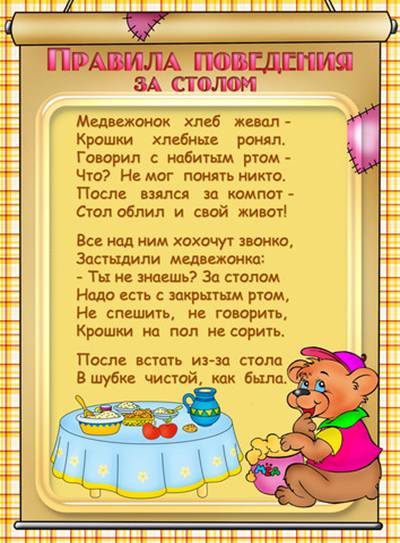
Process nuances
Each type of activity (games, food, walks, learning) must be carried out in compliance with certain nuances. With their help, you can make your child more energetic and cheerful.
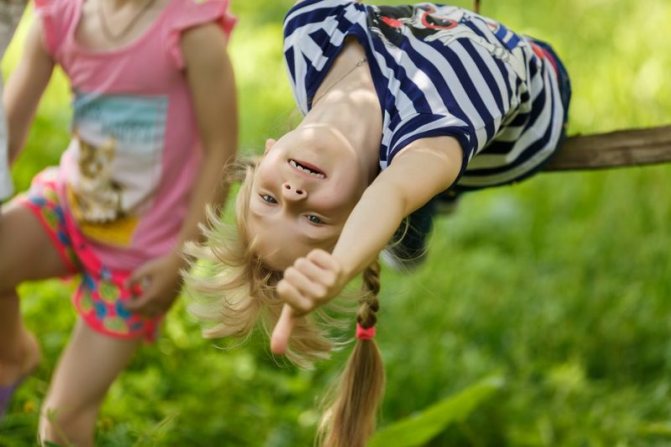
Nutrition rules
In order for a child to grow up healthy and receive all the necessary vitamins, he needs to be provided with proper and balanced nutrition. The best option would be to distribute food evenly throughout the entire waking period. Doctors recommend following the following frequency:
- Children under 3 years old. At this age, it is enough to provide four meals a day (breakfast, lunch, afternoon snack, dinner).
- From 3 to 5 years. Babies belonging to this age category are also recommended to eat 4 times a day. At the same time, light snacks (fruit, ice cream, sweets, desserts) are allowed between meals.
- From 5 years to school entry. Children at this age should be provided with five meals a day as they need more energy to learn and prepare for school.
It is equally important to choose the right products for your daily diet. All harmful ingredients that can negatively affect the functioning of the digestive system should be excluded from the general list.
Key points to consider when choosing products:
- The daily diet must include the following ingredients: butter, milk, stewed or steamed meat, porridge (rice, buckwheat, oatmeal), potatoes, bread, as well as fresh vegetables and fruits.
- About 2 or 3 times a week you need to pamper your child with fish stews, cottage cheese, hard cheese and eggs.
- The preschooler's menu should be constantly changing. It is important that the products consumed are repeated as rarely as possible.
- Meat must be combined with cereals or vegetables.
- It is recommended to give your child a small portion of salad before meals. With the help of this dish, the secretion of gastric juice will be stimulated, which will have a positive effect on appetite.
- Sweet and juicy fruits are best eaten in the evening.
Sleep organization
In order for the baby to fully rest, it is necessary to provide him with appropriate conditions. The optimal duration of sleep depends on age and individual characteristics of the body. Children under 5 years old are recommended to rest at least 12 hours a day (9 hours at night and 3 during the day). Older boys and girls should sleep 1 hour less.
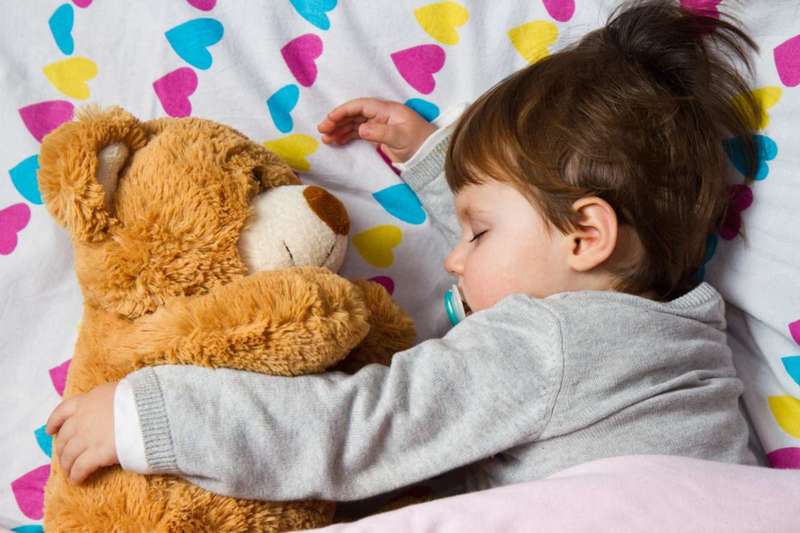
In order for the child to fall asleep quickly, it is recommended to avoid activities that excite the nervous system 1-2 hours before rest. These include:
- noisy games;
- sitting at a computer;
- watching TV.
Very often, preschoolers refuse to nap during the day. You can replace it with some low-active activities (reading, passive games, lying on the bed). Lack of sleep leads to poor mood, health, and learning ability.
Walking and physical activity
To improve health, it is necessary to include regular walks in the fresh air and outdoor games in a preschooler’s daily routine. Doctors recommend walking regularly, except on rainy and very cold days.
Daily walks will help improve:
- metabolic rate;
- functioning of the cardiovascular system;
- resistance to various diseases;
- state of the respiratory system.
A combination of fresh air and physical activity will be beneficial for your baby. It is allowed to perform any actions that will help strengthen health and immunity. It's best to do:
- running warm-up;
- sports games (football, basketball, badminton);
- exercises aimed at strengthening the muscular system (pull-ups on the horizontal bar, push-ups);
- entertaining games.
Regime in kindergarten as the basis for organizing children's lives
Elina Gribanova
Regime in kindergarten as the basis for organizing children's lives
As you know, human health begins in early childhood , and a daily routine plays of a child’s body . Its compliance is ensured by preschool educational institutions, taking into account the physiology of children of each age group.
bring their children to kindergarten , the first thing they hear is the words “ regime ”
,
"routine"
.
For some, especially inexperienced, fathers and mothers, these words are alarming and alarming. “Will life according to the schedule too difficult for the child?”, “Will the child be able to join the team, will he get used to living according to the schedule?”
- educators often hear such questions from parents.
After all, life is rarely built according to strict temporary rules, and children get used to a free schedule of life activities . Games and walks in the family are also organized spontaneously , depending on the mood or when parents have free time.
The daily routine is based on a comprehensive study of the physiology and psychology of children by the best specialists in these fields, and its main goal is to satisfy all the basic needs of the child’s body and strengthen the health of children.
Principles for creating a daily routine in a preschool educational institution
— Suitable for the age of children . Uniting into groups the third year of life , the fourth year, etc. makes it possible to meet the needs of pupils, which change every year. For example, short educational activities are carried out with young children, 10 minutes each, in the middle group educational activities last 20 minutes, the number of educational activities increases, from two per day in the younger groups to three in the senior and preparatory groups. Younger children have more time to eat, prepare for a walk and sleep.
- Rhythm. Duration and alternation of routine moments (different types of activities)
during the day, meet the needs
of the child’s body for food , rest, and movement.
In addition, the periods of greatest activity, the performance of preschoolers and the need to recuperate after mental and physical stress are taken into account. — Cyclicity of regime moments . Eating, organized educational activities, sleep, hygiene procedures are present in the routine every day and are repeated at the same time. children develop both useful reflexes (appetite comes at a certain time) and habits: children learn to wash their hands before eating, do exercises in the morning, and play outdoor games.
— Alternation of activities. The children's activities are organized so that mental stress alternates with physical ones, in addition, the children's need for play and movement .
— Flexibility, individual approach. The group teacher is obliged to ensure compliance with the regime , however, the individual characteristics of the children are also taken into account. There are children who do not like noisy games, get tired faster, and need additional rest. For such children, there are privacy corners in each group, where the child can simply sit with his favorite toy or look at illustrations in a book. Weak, often ill children are recommended to be put to bed first and woken last. Children have food preferences that need to be taken into account.
— Consistency and gradualism. All processes go one after another, are logically interconnected, and in order to move on to the next one, you need to complete the previous one (collect toys, go out to get dressed for a walk, wash your hands before eating). When a child begins to understand why all this needs to be done, it is much easier for him to get used to the routine.
Morning reception and free activities for children
How you greet the day is how you will spend it (Russian proverb)
Popular wisdom is right: the child’s entire future day depends on the first minutes of a child’s stay in kindergarten . Therefore, it is so important to create a favorable emotional background in the group, set the kids up in a positive mood, make it clear that they are welcome in kindergarten , and that there is a lot of interesting and fun ahead. The teacher’s friendly smile, gentle tone of speech, and genuine interest in the baby’s condition will make it possible to conduct a morning appointment without tears and sadness, even in the younger group, where it is still very difficult for children to part with their parents for at least half a day.
To make a child willing to go to kindergarten , you can use: a bright, beautiful toy, surprise moments, for very little ones - a new doll, a car. The main thing is that the offer to play with them is made in a friendly tone, and the child enters the group, holding the teacher’s hand, trusting him and getting used to communicating with him. The mother may be nearby, but the teacher, as the person who will be with the baby all day, must encourage the child to interact and respond emotionally to his words.
Older children, who are accustomed to kindergarten , trust the teacher, usually go to the group willingly, are happy to meet friends, rush to share news, and immediately engage in conversation and play. But even older schoolchildren sometimes have a bad mood and a reluctance to go to kindergarten . They can also be captivated by a new game (construction set, puzzles, or interested in a work assignment, a new unusual activity.
Timid, shy children, as well as newcomers to the group of any age, require special attention during the morning reception. It is necessary to ask the parents in advance what the child is interested in, and offer him this type of activity in the free hours before gymnastics.
Often in the warm season, the morning reception is held outside. The teacher chooses the brightest and most interesting: an elegant doll (for kids)
etc. Older children will be interested in a kite, soap bubbles, a pinwheel - a windmill.
At the same time, it is possible to observe the properties of wind and other natural phenomena. A creative, imaginative teacher will be able to captivate children by observing the flowers in the flowerbed, the behavior of birds or ants, the beauty of autumn trees, clouds and other phenomena of the surrounding world.
Older preschoolers are very fond of the morning reception in the form of a “minute of kindness”
or
“friendship circle”
, when all group mates stand in a circle with the teacher, say warm words to each other and give each other a smile.
We should not forget about fostering a culture of behavior: children should greet the teacher and peers, communicate kindly and politely.
Hygiene procedures, self-care
The implementation of these routine moments in different groups also has some differences:
— The purpose of hygiene procedures in younger groups is to teach children self-care skills, and at an older age, the acquired skills are consolidated and form the ability to perform them independently, without reminders, based on ideas about their necessity and benefits.
— Techniques for developing cultural and hygienic skills differ for different ages. They are most appropriate in groups of early and primary preschool age:
— Show;
— Explanation;
— Direct guidance of actions (the teacher rolls up the children’s sleeves; soaps their hands; holding the child’s palms in his hands, makes circular movements with them, developing a motor skill);
— Use of artistic words, folklore;
— Game techniques (a doll or another character comes to the children, to whom they show how to wash themselves, dress for a walk, fold clothes).
Older preschoolers no longer need to be shown all the stages of washing and dressing; a question, reminder, encouragement, and praise are enough for them. To consolidate knowledge about the benefits of hygiene procedures, children of older groups can be shown:
— Fragment of the cartoon “Moidodyr”
or use slides;
— Multimedia presentation about hygiene products, clothing items, depending on the technical equipment of the group.
Reception of encouragement and praise is relevant in all age groups, but comparison with other children is undesirable (unacceptable)
. It is permissible to compare only the achievements of the child himself, past and present, emphasizing progress: “Yesterday you didn’t succeed, but today you rolled up your sleeves, washed your hands clean, carefully turned and folded your clothes, you did well today!”
Older preschoolers should not only be able to undress independently for bed and dress for a walk, eat with a spoon, fork, and use a knife. They also put their clothes in order on their own, tie shoelaces, fasten buttons, take care of their appearance and eliminate clutter: comb their hair, straighten their collar, tuck a shirt, T-shirt into tights or trousers. In the junior and middle groups, most of the procedures for caring for the pupils’ appearance are carried out by the teacher and his assistant, gradually accustoming the children .
Eating, table manners
Rational organization of nutrition in kindergarten primarily depends on strict adherence to the regime . Breakfast, lunch, and afternoon tea should be served at the same time every day, without delay, since long waits can reduce children's . Half an hour before meals, stop noisy and active games; it is better to read a book to the children, or play board games.
The guys are sure to be introduced to the menu, told what will be served: this broadens their horizons, enriches their vocabulary and, of course, whets their appetite. Many pupils adore the menu of the preschool institution and ask to prepare food at home “like in kindergarten”
.
Psychology comes into play here, because being in a group, with friends, is much more interesting than at home with adults. Walking in the fresh air plays a big role in a positive perception of food; after walking, dinners seem to taste better. Refusal to eat may indicate the onset of an illness , a bad mood, or some problem of the child that seems insignificant to an adult, but depresses him (a quarrel with friends, lost a toy)
. The teacher should talk to the child and reassure him, but if the problem is not solved, it is worth monitoring the baby’s condition until the evening.
It is also important how the dishes themselves are prepared. Their aesthetic design, taste, and menu variety help increase appetite.
It is necessary to ensure that in the intervals between feedings the pupils do not consume sweets that they bring from home.
Eating is an excellent opportunity to develop cultural and hygienic skills. Children in the younger group learn to sit at the table with clean hands, sit upright, not fidget, eat food slowly, not crumble bread, and finish the entire portion. They are also taught to use a napkin, and older children - a fork . Kindergarten pupils learn to use a knife in the older group.
An important element in fostering a culture of eating is serving in the dining room. It is introduced in the second younger group in the form of instructions (arrange cups, plates for bread)
and they completely entrust table setting to children of older groups
(children arrange all the dishes, napkin holders, and then clear the table)
.
to organize duty in such a way that those on duty are not late for bed and do not leave too early from a walk.
This can be achieved by pairing up those who can quickly set the table with slower children. Being on duty in the canteen fosters responsibility, accuracy, and the ability to efficiently and quickly complete the assigned task. Types of activities in routine of a preschool institution
The daily routine provides for various types of children's , the most significant of which are:
- Game room. There are games with rules (moving, didactic)
and creative (
director's , role-playing, improvisation, construction, fantasy).
- Cognitive - research. This includes experimentation, elementary experiments, modeling of objects and situations.
— Communicative (communication with adults and peers)
.
— Fine (drawing, applique, modeling)
.
— Design and artistic work.
— Self-service and work in nature, everyday life.
— Musical (singing, rhythmic movements to music, playing children's musical instruments).
— Perception of fiction (listening, discussion, memorization and storytelling)
.
— Motor (sports games, gymnastics, children’s tourism )
.
Organized educational activities with children are carried out in the form of developing problem-based, playful and practical educational situations in accordance with educational areas. Educational situations are constructed as an exciting problem-based cognitive activity. Gaming techniques and various types of visualization are actively used, including diagrams, subject and conditionally graphic models. Educational situations are predominantly integrative, problem-searching in nature, imply cognitive communication, joint activities with the teacher and the active independence of children in solving problems (social, communicative, cognitive, artistic, motor, environmental, creative)
The list of routine moments is somewhat smaller; it includes sleep, eating, hardening, and walking. The time intervals allocated for routine moments differ in different groups.
Features of walks
A walk during routine of a preschool institution is extremely important, and its benefits for children are undeniable for the following reasons:
— Staying in the fresh air saturates the body with oxygen , strengthens and hardens thanks to natural factors.
— Children have the opportunity to move freely in a spacious area, run, and do physical exercises that are not always appropriate in a group.
— Children who like to make noise do not need to restrain themselves, because during a walk they are allowed to shout and play noisy games, which is not welcome indoors.
— In addition to physical development, walking also brings cognitive benefits. After all, during them, children have the opportunity to observe natural phenomena, animals, plants, the work of adults, transport, houses, passers-by, and also engage in research activities. It is organized , of course, by the teacher.
- Kids can be offered simple experiments: drawing patterns on wet sand, footprints in the snow, bringing a snowball into the group.
— Older preschoolers will be interested in watching the change in the length of a shadow during the day or tracking what happens to candy if left near an anthill.
Kindergarten pupils walk on the site : after morning classes and after afternoon tea. Club activities, entertainment, matinees and other events cannot be the reason for canceling a walk.
Severe frost and wind, as well as heavy rain and ice can be a reason to cancel your stay in the fresh air. In light rain, children can walk under awnings and on verandas, which should be on each site.
The walk includes the following components:
Observation.
— In younger groups, observations of large, bright, clearly shaped objects in close proximity to children are organized . These can be trees, shrubs, flowers, herbaceous plants, birds, butterflies, freight and passenger transport, and site equipment.
— Long-term observations of plant growth, animal behavior, and changes in the environment for 1–2 weeks begin in the middle group. Then you can invite children to draw the object of observation.
— Older preschoolers are able not only to observe phenomena and objects, but also to discover relationships between them and explain the reasons for what is happening. With children of the sixth and seventh year of life, you can conduct entertaining observations in the form of games “Find what was not around yesterday, but is today”
.
Outdoor games.
During a walk, 2-3 outdoor games should be played in the first and second junior groups, and 3-4 games in senior groups.
When planning games, the teacher selects them in such a way that they serve the development of various physical qualities. Kids are very fond of outdoor games - fun in which the teacher sings or reads the words of the game, and the children perform the corresponding movements. In the senior and preparatory groups, children can organize and conduct outdoor games independently, with a little supervision from the teacher.
Didactic games.
They are both group and individual in nature, and are most often combined with the topic of observation carried out during a walk, but they can also serve a specific task set by the teacher (development of coherent speech, sound pronunciation, counting skills, consolidation of knowledge about what was learned in class) . An excellent addition to a walk would be a creative game - an imaginary journey on a ship, plane, car to the forest, to the sea, even into space.
Individual work. You shouldn't forget about it either. Development of motor skills, speech development, development of memory, thinking, attention, imagination, nurturing a culture of behavior, friendship, respect for nature - a teacher can pay attention to all this when working with one or two preschoolers, while the rest are busy with independent play activities.
Labor activity.
Helping the janitor in cleaning the area, working in the garden, in the flower garden will give not only vigor and strength, but also joy to children, because they want to be needed, to do something socially significant and useful.
— It is the teacher’s responsibility to regulate the workload and monitor the condition of children . Pupils should not lift weights, stay in static positions for a long time, bending over, squatting, or use dangerous tools.
- Kids can be tasked with clearing snow from paths and removing large leaves from the site.
“The elders can fully clean the site, harvest the crops in the beds, loosen the soil, and water the flower beds.
— The best methods of managing work activities are encouragement, personal example of the teacher, and collective discussion of the results of work. For younger preschoolers, the teacher outlines the result of the work done.
Getting ready for bed, sleeping, getting up gradually
The duration of daytime sleep ranges from 2.5 (younger group)
up to 2 hours
(senior and preparatory)
. In order for both babies and older preschoolers to fall asleep at the right time and sleep soundly before waking up, it is necessary to follow a number of rules:
During bedtime, a friendly, calm atmosphere is created, undressing is carried out without haste, shouting, and children do not need to be urged on . Small children are undressed by adults ; from the second youngest group, children can be given independence, asking them to take off their tights, panties, shirt. They remind you to carefully fold your clothes on the high chair. Older pupils undress themselves and put their clothes in order.
— It is necessary to ensure that all children visit the toilet before going to bed.
— When preparing the bedroom for the children , the assistant teacher does cross ventilation (during a walk)
. When the children are sleeping, the window is left open, but so that there are no drafts.
— Before going to bed, it is permissible to read a poem, a lullaby, a fairy tale of calm content, without dangerous adventures or chases. Some gardens practice music therapy - falling asleep to quiet, measured music.
— During sleep, the teacher or assistant teacher is in the bedroom and makes sure that the children do not lie with their heads covered or their faces buried in the pillow. Children be left unattended in the bedroom.
- Both putting to bed and getting up after sleep are carried out gradually, first raising those who woke up on their own, and then waking up sleeping children .
In order for the kids to wake up properly and become cheerful and cheerful again, gymnastics is carried out after sleep, which sets body for active activity. “Awakening gymnastics” exercises
start in bed (stretching, turning the head, moving arms and legs, gradually moving on to more active movements
(walking, slight bending)
. Running and jumping are not recommended, since after sleep children are not ready for them.
After sleep, some hardening procedures are also carried out: walking on embossed rugs, salt paths, dry body massage with individual soft hands. Older children can perform acupressure self-massage, massage the face, ears, eyebrows, hands, and wrists in a playful way.
Registration of information about the daily routine for parents
In order for routine and benefit their growing bodies , it must be maintained at home. Educators need to conduct continuous explanatory work with parents, promote a healthy lifestyle and adherence to a daily routine, albeit not exactly the same as in kindergarten , but observing the main points (bedtime, meals, walks)
.
Various visual aids for parents, which are posted on stands for public viewing, will be of great help in this. These can be either propaganda posters calling for doing gymnastics, spending more time outdoors, playing sports games with kids, or various types of sources of useful information: folders, wall stands, screens, flip-book stands, etc. The information they contain acquaints parents with the following important moments in the life of children in a preschool institution:
— Group daily routine (indicating the time frame for each routine process ).
— The menu for the day, it is posted in the morning, indicating the grams of all dishes that a child of his age is entitled to. If there is no dinner in kindergarten , but only an afternoon snack, a recommended dinner is included in the menu, according to which parents can adjust the preparation of dishes for the evening feeding of the child.
— Class schedule for the week (general schedule)
.
— Contents of educational activities for the day (classes with topics in the morning and afternoon)
.
— Recommendations from teachers and doctors on how to properly carry out routine routines and hardening procedures, dressing children at different times of the year , which dishes are healthy and which are forbidden for children, how to organize active leisure for preschoolers at home on weekends, etc.
The design of information corners should be colorful, aesthetically attractive, and the recommendations should be understandable and feasible, scientifically based , and well written.
Analysis of the routine for organizing the life activities of children in preschool educational institutions
Control over the implementation of routine processes by group educators is carried out by the head, methodologist, nurse of the preschool educational institution in accordance with the annual plan. The following analysis takes into account the following issues:
— Compliance with the daily routine and organization of the group’s work, taking into account the specifics of the season, day of the week, and the general mood of the children .
— Teachers’ knowledge of the daily routine of children in their age group.
- Eating food on time.
- Does not shorten (lengthen)
whether the time allotted for breakfast, lunch, afternoon snack and dinner.
— Number and duration of OOD, compliance with schedule and hygienic requirements.
— The teacher’s ability to determine the degree of fatigue of children and, in connection with this, alternate the activities of children during educational activities.
— Timely departure for a walk and return from it.
— Compliance with the duration of the walk.
- Getting to bed on time.
— A calm environment in the bedroom that encourages children to relax .
— Compliance with the time allotted for sleep.
— The teacher’s ability to gradually raise children after naps, taking into account their individual characteristics.
— Timely departure for an evening walk.
Based on the results of the inspection, teachers are given methodological recommendations and a number of measures are developed aimed at eliminating shortcomings and errors. Such control is especially necessary if a young, inexperienced teacher joins the team and does not have sufficient knowledge of the forms and methods of organizing routine moments .
The regime is useful and necessary , and children need to be taught it both in kindergarten and at home. In order to raise healthy, dexterous, cheerful children , kindergarten and parents of pupils must direct joint efforts to ensure a rational routine for the life and activities of each child.
We teach to study
This is where the biggest difficulty awaits parents. Children are used to it and love to play. But learning for them is something incomprehensible in principle, and therefore boring and unnecessary. In a group of peers, children study together, which is an additional incentive. In addition, experienced teachers know how to find an approach to children and interest them in the upcoming work. But how can you explain to your child at home what the point is in learning?
Most of us will start to scare the child with the fact that “ignoramuses, when they grow up, work as janitors or loaders.” To a child, such a prospect seems very distant and vague. And besides the fact that he will devalue the work of a loader or janitor for himself, such suggestions will be of no use.
The second option, and also not the best, is bribery: if you read it, you will receive a toy, sweets, or play on the computer. This approach will only create commodity-money relations between the preschooler and adults. The baby will not be interested in the result of his work. It will be important for him to quickly finish what is preventing him from having fun and get the desired reward.
How can you help your child accept the need for classes?
- Appreciate all your child’s achievements: both existing and upcoming ones. Teach it to teach, and not to satisfy your unfulfilled ambitions.
- Don’t cram as much knowledge into it as no one knows everything. First of all, take into account what is interesting to the child himself, comparing with the requirements for readiness for school.
- Do not compare your own child with others who are more successful - this will lower the child’s self-esteem and discourage the desire to learn. Compare with how he himself is progressing.
- You cannot buy the efforts of a preschooler with some benefits, just as you cannot force him to study as a punishment for wrongdoing.
- You cannot punish for mistakes or inability. Parents are helpers, mentors and advisers.
- Always praise your child for any successes, support him, show your pride in his successes and faith in his strength.
- Difficult tasks cannot be excluded. They are most useful for the development of the baby. Just show him that you are always ready to help.
- Stick to the established time of classes, observe age standards for their number per day and duration.
- Diversify your lessons with fun physical education breaks so that your child doesn’t sit too long and get tired.
The daily routine of a preschooler is aimed, first of all, at his development and preparation for learning. Therefore, it is so important to draw it up correctly and strictly adhere to it. This habit will help the child throughout his life. It will make him more confident, organized and productive.
Approximate daily routine for preschoolers
| Climb | 07:45–08:00 |
| Exercise, water treatments | 08:00–08:30 |
| Breakfast | 08:30–09:00 |
| Games and educational activities | 09:00–10:00 |
| Walk | 10:00–12:30 |
| Dinner | 12:30–13:30 |
| Daytime nap | 13:30–15:00 |
| Afternoon snack | 15:00–15:30 |
| Walk | 15:30–17:30 |
| Games and educational activities | 17:30–18:30 |
| Dinner | 18:30–19:00 |
| Quiet games at home or an evening walk | 19:00–20:00 |
| Preparation for sleep | 20:00–20:30 |
| Night sleep | 20:30–08:00 |
Of course, you are free to adjust the recommended routine to the conditions of your family life, taking into account the schedule of your child’s sections and clubs, the presence of older/younger children in the family, parents’ work schedule, etc. When
creating a daily schedule for a preschooler, it is necessary to consider the following factors:
- Nutrition . A preschool child should eat 4–5 times a day: breakfast, lunch, dinner + 1 or 2 snacks. The first meal should be 30–45 minutes after waking up. You should have dinner no later than 1.5 hours before bedtime.
- Dream . At 3-4 years old, children should sleep 13-14 hours a day, at older preschool age - 12-13 hours. This time is divided between daytime and nighttime sleep so that the afternoon meeting with the crib takes 1.5–2 hours.
- Walks . Children need fresh air no less than a balanced diet and healthy sleep. Even on cold winter days, try to spend about 3-4 hours a day outside. In summer, of course, walking time should be increased as much as possible.
- Games . Play is the main activity in preschool age. But don’t forget to alternate different types of games: noisy, active, educational, calm. Before bed - a minimum of activity. You can run and scream outside. Give your child time to play independently according to his own rules.
- Developmental activities . Speech development, the basics of mathematics, the world around us - the disciplines of preschool pedagogy should be taught in an easy, fun, playful way. At this age, involuntary attention and memory dominate, which means that no matter how hard he wants, the baby will not be able to diligently gnaw on the granite of science if the activity is uninteresting for him. You can study not at a strictly designated time, but between times: on the way to kindergarten, on a walk, on public transport, while cleaning or preparing food...
Sources
- https://mosmama.ru/2822-rezhim-v-detskom-sadu.html
- https://be-happywoman.ru/vospitanie-detej/rezhim-v-detskom-sadu-dlya-trehletok
- https://vospitanie.guru/doshkolniki/rezhim-dnya-v-detskom-sadu
- https://VseProRebenka.ru/uhod/rasporyadok/dnya-v-detskom-sadu.html
- https://Razvivashka.online/rezhim/rasporyadok-dnya-doshkolnika
- https://friendly-life.ru/rezhim-dnya-doshkolnika/
- https://NII-Evrika.ru/rasporyadok-dnya-doshkolnika/
[collapse]
Lunch time in a preschool
Now let’s figure out what time lunch is in kindergarten.
So, after the walk is over, the teacher and nanny help the kids take off their outerwear. Then the children wash their hands and take their seats at the tables. The teacher's assistant has already brought food to the group. Lunch time in the kindergarten is approximately from half past one to one. It should be noted that eating during the day is a little longer than in the morning, during breakfast. The lunch menu includes first, second and third courses.
Children are offered salads with heat treatment or sliced fresh vegetables. The first course is hot - vegetable soup, borscht, cabbage soup, pickle, that is, all first courses should contain meat. For the second course, children are offered fish, meat, poultry, liver and a side dish. The third dish, as a rule, is a compote of fresh fruits or dried fruits. Bread is also provided.
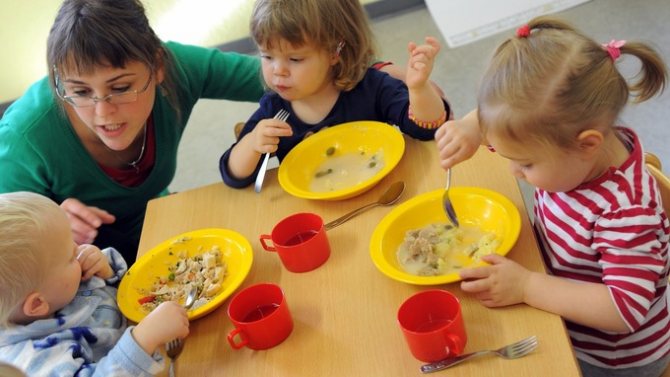
Lunch in kindergarten can be different for each child. Some children already eat all the dishes offered on their own, while others either do not know how or do not want to do this, because they are used to being fed by their parents at home. In addition, not all children eat everything that is placed in front of them on plates. Some people don’t eat beetroot caviar, semolina porridge or stew. Some people can't stand cutlets and soups. Typically, the teacher does not force children to eat foods that they reject. But parents, for their part, must warn the teacher in advance that the child categorically does not accept, or for health reasons, some products are not suitable for him.
Physical exercise and hygiene
It is better to do gymnastics with your child in the first half of the day, an hour after breakfast. He needs exercise for normal development. It is better to do them with fun, rhythmic music, and they can be presented in the form of interesting outdoor games. The main thing is that the baby enjoys this process.
There are several types of exercises for children at three years old:
- articulatory, helping to improve speech skills;
- gymnastics for arms and legs for the development of motor skills (flexion, extension, squats, rotation);
- breathing exercises that improve lung ventilation.
Children with problems pronouncing certain sounds and letters are recommended to engage in special speech therapy gymnastics, as well as sing more, stretching out words.
Due to increased motor function, hygiene procedures must be regular. They differ little from those carried out at 2 years old, but now parents increasingly have to examine the child’s body for abrasions and bruises. For processing, you will need the usual means in this case - peroxide, iodine, potassium permanganate.
It is worth paying attention to teaching your baby to self-care. At the age of three years, a child should already be able to:
- wash your face and brush your teeth;
- wash your hands several times a day;
- rinse your mouth after eating;
- sit on the potty and wipe your butt with napkins or toilet paper;
- operate with cutlery;
- put your things away;
- take off your shoes and remove your outerwear, as well as your headdress;
- clean yourself after games, activities on the table, after washing - in the bathroom.
In developing good habits for children, the most important thing is to set an example, since they imitate their parents in everything.





